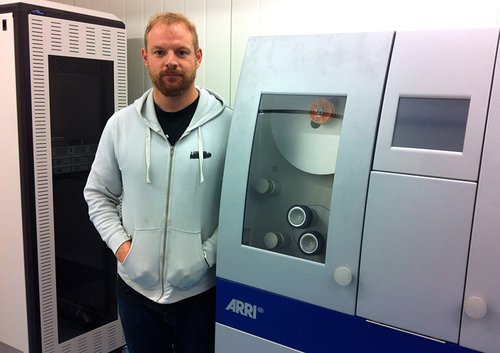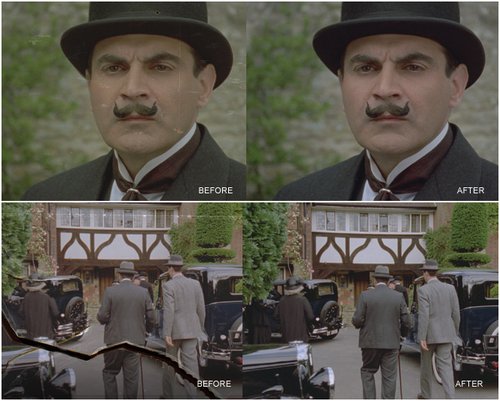
Interview with Richard Falkner, by Nell Williams (Ngā Taonga Sound & Vision)
A partnership with New Zealand Film Commission and the Ministry of Culture and Heritage facilitated the arrival of the ARRISCAN, all the way from ARRI Motion Picture Company in Germany.
The ARRISCAN is the industry standard 16 and 35mm film scanner. In the past, its primary use was in post-production facilities to scan film negative to be edited and manipulated in an intermediate digital process, eventually being printed back out onto film negative for copying and distribution. Now considered the creme-de-la-creme for film digitisation, the ARRISCAN has a significant role to play in the protection of archival moving image footage and in turn, promises generational access to the stories this footage holds.
From the ARRI website – “The development of the ARRISCAN film scanner enables high-resolution, high-dynamic range, pin-registered film scanning for use in the digital intermediate process. Representing the first step in transferring film images into the digital realm, the ARRISCAN enables practically limitless creative possibilities in the DI. It utilises a specially designed CMOS area sensor mounted on a micro-positioning platform and a custom LED light source.”
The significance of these tech-specs will be lost on laymen (e.g., yours truly), but clearly this beast has some pretty grunty technical ability. The moving image conservation team found that out first-hand in February, when they went to the first Film Restoration School Asia in Singapore, for a crash course on what these kinds of incredible machines are capable of.
Hero image: Richard Falkner with the ARRISCAN, a film scanner.

Screen captured images showing ITV’s Poirot (16mm, 1989) before and after ARRISCAN treatment.
So let’s get real – what does the ARRISCAN mean for the moving image collection at Ngā Taonga Sound & Vision?
“The ARRISCAN means we can preserve an image that represents the original material as closely as possible,” explains Richard Falkner, one of our Moving Image Conservators. “The machine is also gentle enough to handle some of our really old nitrate films. That means that not only can we digitise some of the more recent kiwi features and shorts at their best, we can protect some of our oldest and most fragile content, extending its availability to New Zealanders now and in the future.”
Traditional photochemical duplication is far from ideal, as the negative unavoidably suffers in the process. Every time a frame of moving image footage is duplicated, depth and details are lost, contrast is increased, and grain and noise are introduced, resulting in the very harsh and scratchy old copies of films we associate with old cinema. Additionally, the facilities and the materials for photochemical film production have now almost entirely disappeared.
“Digital processes create a huge opportunity for archives,” says Falkner. “The ARRISCAN, which has been operational here since July, allows each frame to be scanned in great detail, without the generational loss you would expect from the traditional photochemical process of duplication, in which essentially light is shone through the original positive and onto raw stock to create a new negative copy, from which new prints are made. “

Richard Falkner on duty data-wranglin’.
Falkner works on the front-line of Ngā Taonga Sound & Vision’s film digitisation work. He’s been learning how to operate the hardware and software that supports it, which has been, he says, “a huge learning curve”. He’s also been mapping out ideas to help the organisation cope with the huge amounts of data that end up whizzing around in the digitisation workflow.
How much data are we talking? LOTS.
“Let’s imagine there’s a feature film we want to digitise, and it’s six reels long. A reel is 2,000 ft long. That’s 12,000 feet times 16 frames per foot, equalling 192,000 frames. Each frame, scanned at 4k (4,048 pixels across), is about 50MB. So for this one film you’re looking at about 9,600,000MB, or 9,375GB, or 9.3 terabytes. That’s two or three large hard drives, by today’s standards. For each film!”
Add to this the data duplication needed for backup, accessioning, storage, reference and possible post-production, and you have maybe 46 odd terabytes floating around until the process has been completed. There’s a lot of time and technical resource on the line, and ARRISCAN helps ensure the best possible quality image is captured, first time.
Those who have seen the results of ARRISCAN digitisation are suitably impressed. And there’s loads more to come, as Falkner excitedly explains.
“We’re already putting fairly large quantities of New Zealand titles through the machine, from New Zealand short and feature films, to World War One footage, to 16mm art films, and historical footage of Stewart Island communities… I see us continuing to digitise a diverse range of New Zealand’s most important and critical titles and materials. It’s very exciting!”